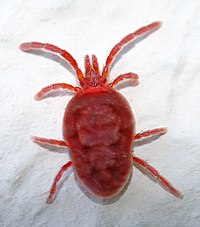
The Mite Tyrophagus putrescentiae Hosts Population-Specific Microbiomes That Respond Weakly to Starvation
Sign Up to like & getrecommendations! Published in 2018 at "Microbial Ecology"
DOI: 10.1007/s00248-018-1224-y
Abstract: The effect of short-term nutrient deprivation was studied in five populations of the mite Tyrophagus putrescentiae with different microbiomes. The fresh weight, nutrient status, respiration, and population growth of the mites were observed for the… read more here.
Keywords: population growth; starvation; respiration; mite ... See more keywords

Contrasting structures of plant–mite networks compounded by phytophagous and predatory mite species
Sign Up to like & getrecommendations! Published in 2018 at "Experimental and Applied Acarology"
DOI: 10.1007/s10493-018-0250-2
Abstract: Differences in the feeding habits between phytophagous and predatory species can determine distinct ecological interactions between mites and their host plants. Herein, plant–mite networks were constructed using available literature on plant-dwelling mites from Brazilian natural… read more here.
Keywords: plant; phytophagous predatory; mite species; mite networks ... See more keywords

Euseius concordis (chant) (Acari: Phytoseiidae) as a potential agent for the control of yerba mate red mite Oligonychus yothersi (McGregor) (Acari: Tetranychidae)
Sign Up to like & getrecommendations! Published in 2021 at "Phytoparasitica"
DOI: 10.1007/s12600-020-00879-4
Abstract: Oligonychus yothersi (McGregor) (Acari: Tetranychidae), known as yerba mate red mite, is typically found on the abaxial face of leaves, feeding on mesophyll cell contents in yerba mate crops. Euseius concordis (Chant) is a generalist… read more here.
Keywords: acari; concordis; control; yerba mate ... See more keywords

Development of single nucleotide polymorphism markers specific to Apis mellifera (Hymenoptera: Apidae) line displaying high hygienic behavior against Varroa destructor, an ectoparasitic mite
Sign Up to like & getrecommendations! Published in 2019 at "Journal of Asia-pacific Entomology"
DOI: 10.1016/j.aspen.2019.08.005
Abstract: Abstract To control Varroa destructor, an ectoparasitic mite, a honey bee line possessing high hygienic behavior (HHB) against this mite has been bred in South Korea. However, a method that can diagnose and assess the… read more here.
Keywords: hygienic behavior; polymorphism; mite; line ... See more keywords

Genome-wide identification of miRNAs and target regulatory network in the invasive ectoparasitic mite Varroa destructor.
Sign Up to like & getrecommendations! Published in 2021 at "Genomics"
DOI: 10.1016/j.ygeno.2021.05.028
Abstract: Varroa destructor is an ectoparasite mite that attacks bees leading to colony disorders worldwide. microRNAs (miRNAs) are key molecules used by eukaryotes to post-transcriptional control of gene expression. Nevertheless, still lack information about V. destructor… read more here.
Keywords: genome wide; wide identification; varroa destructor; destructor ... See more keywords

Rapid adaptation in phoretic mite development time
Sign Up to like & getrecommendations! Published in 2018 at "Scientific Reports"
DOI: 10.1038/s41598-018-34798-6
Abstract: Strong ecological selection can erode genetic variation and render populations unable to deal with changes in ecological conditions. In the adaptation of the phoretic mite Poecilochirus carabi to its host, the burying beetle Nicrophorus vespilloides,… read more here.
Keywords: development time; mite development; mite; genetic variation ... See more keywords

Gaeolaelaps scarites sp. nov., a new laelapid mite (Acari: Mesostigmata) associated with Scarites terricola (Coleoptera: Carabidae) from Iran
Sign Up to like & getrecommendations! Published in 2019 at "International Journal of Acarology"
DOI: 10.1080/01647954.2018.1554701
Abstract: ABSTRACT A new mite species of the genus Gaeolaelaps, G. scarites Joharchi and Saeidi sp. nov., collected from under the elytra and on the abdomen of Scarites (Parallelomorphus) terricola Bonelli (Coleoptera: Carabidae) in Iran is… read more here.
Keywords: zoobank org; carabidae iran; coleoptera carabidae; gaeolaelaps scarites ... See more keywords

The Use of the Predatory Mite Stratiolaelaps scimitus (Mesostigmata: Laelapidae) to Control Varroa destructor (Mesostigmata: Varroidae) in Honey Bee Colonies in Early and Late Fall.
Sign Up to like & getrecommendations! Published in 2019 at "Journal of economic entomology"
DOI: 10.1093/jee/toy418
Abstract: The ectoparasitic mite Varroa destructor Anderson & Trueman is a major pest of the honey bee Apis mellifera L. (Hymenoptera: Apidae) and its control is one of the most important challenges that beekeepers have to… read more here.
Keywords: mite; early late; late fall; honey bee ... See more keywords

Haemolymph removal by Varroa mite destabilizes the dynamical interaction between immune effectors and virus in bees, as predicted by Volterra's model
Sign Up to like & getrecommendations! Published in 2019 at "Proceedings of the Royal Society B: Biological Sciences"
DOI: 10.1098/rspb.2019.0331
Abstract: The association between the deformed wing virus and the parasitic mite Varroa destructor has been identified as a major cause of worldwide honeybee colony losses. The mite acts as a vector of the viral pathogen… read more here.
Keywords: immune effectors; haemolymph removal; removal; mite ... See more keywords

Costs of weaponry: Unarmed males sire more offspring than armed males in a male‐dimorphic mite
Sign Up to like & getrecommendations! Published in 2019 at "Journal of Evolutionary Biology"
DOI: 10.1111/jeb.13402
Abstract: Morphological structures used as weapons in male–male competition are not only costly to develop but are also probably costly to maintain during adulthood. Therefore, having weapons could reduce the energy available for other fitness‐enhancing actions,… read more here.
Keywords: male dimorphic; armed males; mite; sired offspring ... See more keywords

An accidental finding of a demodectic mite on a slide: Demodex folliculorum (Simon) (Acari: Demodecidae)
Sign Up to like & getrecommendations! Published in 2019 at "Systematic and Applied Acarology"
DOI: 10.11158/saa.24.5.16
Abstract: This paper presents accidental occurrence of a human skin mite, Demodex folliculorum (Simon) (Acari: Demodecidae), on a microscopic slide in Turkey. read more here.
Keywords: simon acari; demodex folliculorum; folliculorum simon; mite ... See more keywords